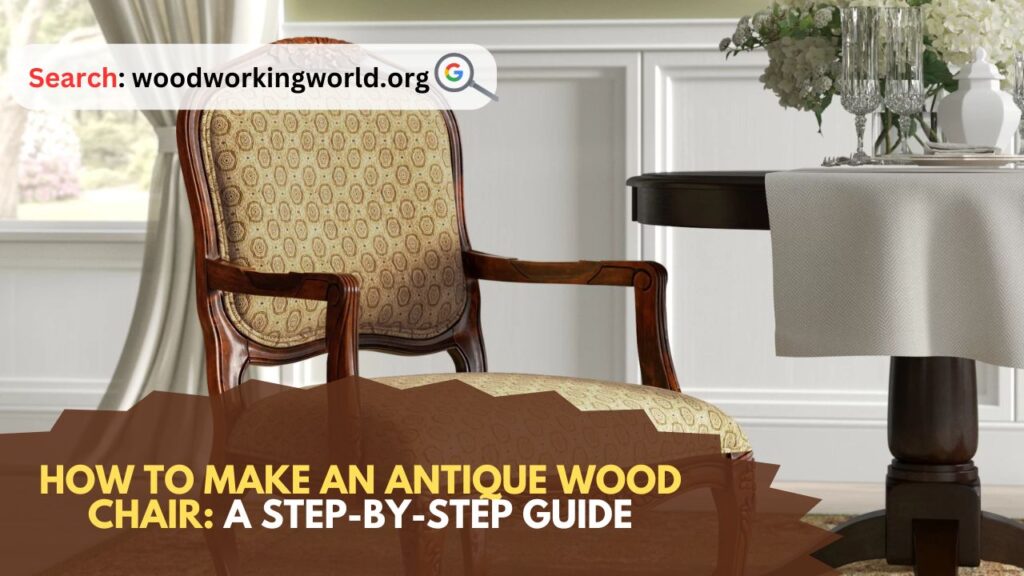Antique Wood Chair: Creating an antique wood chair is a fulfilling project that combines craftsmanship, attention to detail, and a love for traditional aesthetics. Whether you’re a seasoned woodworker or a beginner, this guide will walk you through the steps to make a beautiful antique-style chair that will be a cherished piece in your home. Let’s dive into the process of making an antique wood chair from selecting the right wood to applying the final touches.

How to Make an Antique Wood Chair
Materials and Tools Needed to Make an Antique Wood Chair
Materials:
- Hardwood (oak, cherry, walnut, or mahogany)
- Wood glue
- Sandpaper (various grits)
- Wood stain or paint
- Varnish or polyurethane
- Upholstery fabric (optional)
- Foam padding (optional)
- Nails or screws
Tools:
- Table saw or hand saw
- Jigsaw
- Drill
- Chisels
- Mallet
- Clamps
- Tape measure
- Square
- Wood planer
- Router
- Sanding block or power sander
- Paintbrushes or rags for staining
Step 1: Design and Planning
Before you start cutting wood, you need a clear plan and design for your antique chair. You can find design templates online or create your own based on antique furniture styles. Key features to consider include the shape of the legs, the style of the backrest, and any decorative elements such as carvings or inlays.
Design Tips:
- Antique chairs often feature curved lines and ornate details.
- Pay attention to proportions to ensure the chair is comfortable and functional.
- Consider whether you want an upholstered seat or a wooden seat.
Step 2: Selecting the Wood
Choosing the right wood is crucial for both the durability and the aesthetic of your chair. Hardwoods like oak, cherry, walnut, and mahogany are excellent choices for antique furniture due to their strength and beautiful grain patterns.
Wood Selection Tips:
- Ensure the wood is properly dried to prevent warping.
- Look for pieces with a straight grain and minimal knots.
- Consider the color and grain pattern that will best suit your desired antique finish.
Step 3: Cutting the Wood
Once you have your design and wood, it’s time to start cutting. Use your table saw or hand saw to cut the wood into the necessary pieces for the legs, seat, backrest, and supports.
Cutting Tips:
- Measure twice, cut once. Precision is key in woodworking.
- Use a square to ensure your cuts are at right angles.
- For curved pieces, use a jigsaw to achieve smooth curves.
Step 4: Shaping the Components
With the pieces cut to size, you’ll need to shape them according to your design. This might involve using a wood planer to achieve the desired thickness, a router to add decorative edges, and chisels for any intricate carvings.
Shaping Tips:
- Work slowly and carefully, especially when carving details.
- Use clamps to secure your workpiece while shaping it.
- Sand the edges and surfaces smooth after shaping.
Step 5: Assembling the Chair
Begin assembling your chair by first constructing the frame. Use wood glue and clamps to hold the pieces together while the glue dries. Reinforce the joints with nails or screws for added strength.
Assembly Tips:
- Dry fit all the pieces before gluing to ensure everything fits properly.
- Wipe away excess glue immediately to prevent staining.
- Use a square to check that the frame remains aligned during assembly.
Step 6: Adding Decorative Elements
This step is optional but adds a lot of character to your antique chair. You can add carvings, inlays, or other decorative elements to the backrest or legs.
Decorative Tips:
- Plan your design on paper before starting.
- Use a small chisel and mallet for fine details.
- Practice on scrap wood before working on your chair.
Step 7: Sanding
Sanding is crucial for a smooth finish. Start with a coarse grit sandpaper to remove any rough spots and gradually move to finer grits for a silky smooth surface.
Sanding Tips:
- Sand in the direction of the grain to avoid scratches.
- Use a sanding block or power sander for large, flat areas.
- Pay extra attention to carved or detailed areas.
Step 8: Staining or Painting
Now that your chair is assembled and sanded, it’s time to finish it with stain or paint. Staining enhances the natural beauty of the wood, while painting can give a more vibrant look.
Finishing Tips:
- Apply the stain or paint in thin, even coats.
- Use a brush or rag to apply stain, and wipe off excess for an even finish.
- Allow each coat to dry completely before applying the next.
Step 9: Applying Varnish or Polyurethane
To protect your chair and give it a lasting finish, apply several coats of varnish or polyurethane. This will also add a beautiful sheen to the wood.
Varnish Tips:
- Apply in thin, even coats with a high-quality brush.
- Sand lightly between coats with fine-grit sandpaper.
- Ensure a dust-free environment to avoid imperfections in the finish.
Step 10: Upholstering the Seat (Optional)
If you opted for an upholstered seat, this is the final step. Cut foam padding to size and cover it with your chosen fabric. Secure the fabric with a staple gun, ensuring it is tight and smooth.
Upholstery Tips:
- Use high-density foam for comfort and durability.
- Choose a fabric that complements the wood finish.
- Start stapling from the center and work outwards to avoid wrinkles.
Final Thoughts: Antique Wood Chair
Creating an antique wood chair is a project that requires patience, precision, and a love for woodworking. The result is a beautiful piece of furniture that carries the charm and elegance of antique designs. By following these steps and taking your time with each part of the process, you’ll create a chair that not only looks stunning but also stands the test of time.
Whether this is your first woodworking project or you’re adding to your collection of handmade furniture, the skills and techniques you develop in making this chair will serve you well in future projects. Enjoy the process, and take pride in the craftsmanship of your antique wood chair.
I hope this article on Antique Wood Chair has been helpful. If you have any further questions, please feel free to leave a comment below.
Video
